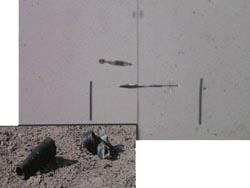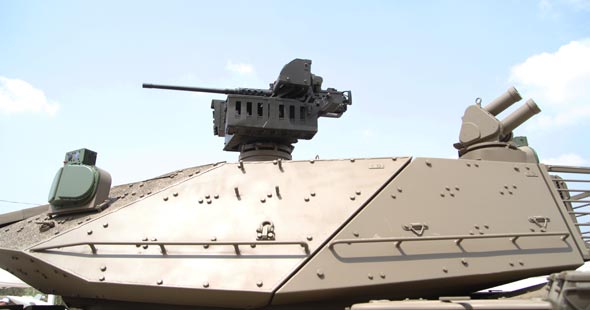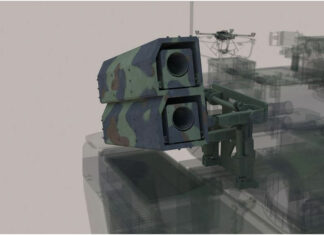In Eurosatory 2006 IMI unveiled its new Active Defense System (ADS) called – Iron Fist. Until recently, the development of Iron Fist was shrouded in secrecy, as it was developed in parallel to a different Israeli developed ADS system – RAFAEL’s Trophy, which entered full scale development in 2005. However, due to rapid development pace and successful testing, IMI expects to deliver the first systems for IDF testing and qualifications by mid 2007. Unlike competing systems, IMI’s Iron Fist can be installed on light vehicles, including trucks and even Humvees, offering effective protection from RPGs. IMI conducted extensive testing against a full spectrum of threats, engaging various types of threats from stationary and moving armored personnel carriers. The system already demonstrated effective protection of light vehicles and heavy armored vehicles, from small rocket propelled grenades, anti-tank missiles and tank rounds equipped with shaped charge warheads as well as advanced kinetic threats (armor piercing tank rounds).
 The system uses a fixed radar sensor, mounted on the protected platform, to detect potential threats, measure distance and trajectory, providing the fire control system with data for calculation of engagement plans. When a threat is identified as imminent, an explosive projectile interceptor is launched toward it. The interceptor, shaped similar to a small mortar bomb, is designed to defeat the threat even when flying in very close proximity. Unlike other systems, the Iron Fist uses only the blast effect to defeat the threat, crushing the soft components of a shaped charge or deflecting and destabilizing the missile or kinetic rod in their flight. The interceptor is made of combustible envelope, fully consumed in the explosion. Without the risk of shrapnel, Iron Fist provides an effective, close-in protection for vehicles operating in dense, urban environment. The use of close proximity, rather than “hit to kill” mechanism avoids complex interception techniques and contributes to reduced cost.
The system uses a fixed radar sensor, mounted on the protected platform, to detect potential threats, measure distance and trajectory, providing the fire control system with data for calculation of engagement plans. When a threat is identified as imminent, an explosive projectile interceptor is launched toward it. The interceptor, shaped similar to a small mortar bomb, is designed to defeat the threat even when flying in very close proximity. Unlike other systems, the Iron Fist uses only the blast effect to defeat the threat, crushing the soft components of a shaped charge or deflecting and destabilizing the missile or kinetic rod in their flight. The interceptor is made of combustible envelope, fully consumed in the explosion. Without the risk of shrapnel, Iron Fist provides an effective, close-in protection for vehicles operating in dense, urban environment. The use of close proximity, rather than “hit to kill” mechanism avoids complex interception techniques and contributes to reduced cost.
One of the main advantages of the Iron Fist is its integration into routine operations. Its sensor provides essential input to situational awareness systems, based on ground radar surveillance, moving target detection, classification and tracking and motion detection. Furthermore, by loading other types of projectiles, such as non lethal, anti-personnel, smoke or illumination, the system can be used in support of routine operation.
Iron Fist is supported by Israel’s MOD Directorate for Defense Research & Development (DDR&D). The program is designed to protect medium and light vehicles, but based on its performance, has the potential to be fielded on heavy armor as well. In future configurations, the system has a growth potential to protect sensitive elements of fixed installations or patrol boats, protecting from RPG attacks, frequently encountered in counter insurgency operations.
At Eurosatory 2008 IMI unveiled an advanced version of the Iron Fist active protection system developed for the protection of medium weight armored protected vehicles such as the Wildcat on which it was installed at the show. Iron Fist uses two twin-tube rotateable launchers employing redesigned fin-stabilized canisters (compared to the previous mortar-like ammunition used in the previous design). IMI claims the canister has better aerodynamic qualities and is more stable in flight, thus enabling the system to address treats at various ranges. Made of composite casing fully consumed by the blast, the system poses minimal risk of collateral damage to nearby troops or non combatants. It is activated by command from the fire control system, employing an Elta Systems conformal, distributed radar system and an infrared sensor called Tandir, developed at Elbit Systems Elisra. Redesigned as a multi-dimensional protection system, Iron-Fist provides the crew with early warning and situational picture of incoming threats, employing ‘soft-kill’ means at mid-range and only if the threat is not eliminated by other means, intercepts it with remotely detonated hard-kill munitions. Iron-Fist can handle multiple targets simultaneously with different intercept methods, including multiple countermeasures fired at two simultaneous threats at the same sector.
At Eurosatory 2008 IMI unveiled an advanced version of the Iron Fist active protection system developed for the protection of medium weight armored protected vehicles such as the Wildcat on which it was installed at the show. Iron Fist uses two twin-tube rotateable launchers employing redesigned fin-stabilized canisters (compared to the previous mortar-like ammunition used in the previous design). IMI claims the canister has better aerodynamic qualities and is more stable in flight, thus enabling the system to address treats at various ranges. Made of composite casing fully consumed by the blast, the system poses minimal risk of collateral damage to nearby troops or non combatants. It is activated by command from the fire control system, employing an Elta Systems conformal, distributed radar system and an infrared sensor called Tandir, developed at Elbit Systems Elisra. Redesigned as a multi-dimensional protection system, Iron-Fist provides the crew with early warning and situational picture of incoming threats, employing ‘soft-kill’ means at mid-range and only if the threat is not eliminated by other means, intercepts it with remotely detonated hard-kill munitions. Iron-Fist can handle multiple targets simultaneously with different intercept methods, including multiple countermeasures fired at two simultaneous threats at the same sector.
June 2009: The Israel Defense Forces (IDF) is moving forward with the development and fielding of active protection systems (APS) for tanks and armored infantry fighting vehicles (AIFV). Maj. General Dan Harel, IDF 2nd in Command has approved the acquisition of ‘Iron Fist’ APS for the Namer AIFVs, parallel to the continued acquisition of Aspro-A (Trophy) systems for the Merkava 4 tanks. Currently in advanced developmental phase, Iron Fist is expected to provide multi-level protection against anti-tank threats, from short range tandem-warhead rockets that demonstrated their ability to defeat reactive armor, to sophisticated, heavy guided missiles such as the Kornet, employed by the Hezbollah during the 2006 2nd Lebanon War. The system has also been designed to counter tank fired (kinetic) threats. Each Iron-Fist system employs two turrets, containing two launch tubes firing the interceptor projectile and several types of sensors, covering 360 degrees. The system can also include various countermeasures, which could attempt to engage threats at extended range with ‘soft kill’, saving ‘hard kill’ means as the last line of defense. By utilizing soft launch techniques, firing loads generated by the Iron Fist are reducing potential adverse effect on the platform’s mobility or fire accuracy.





















